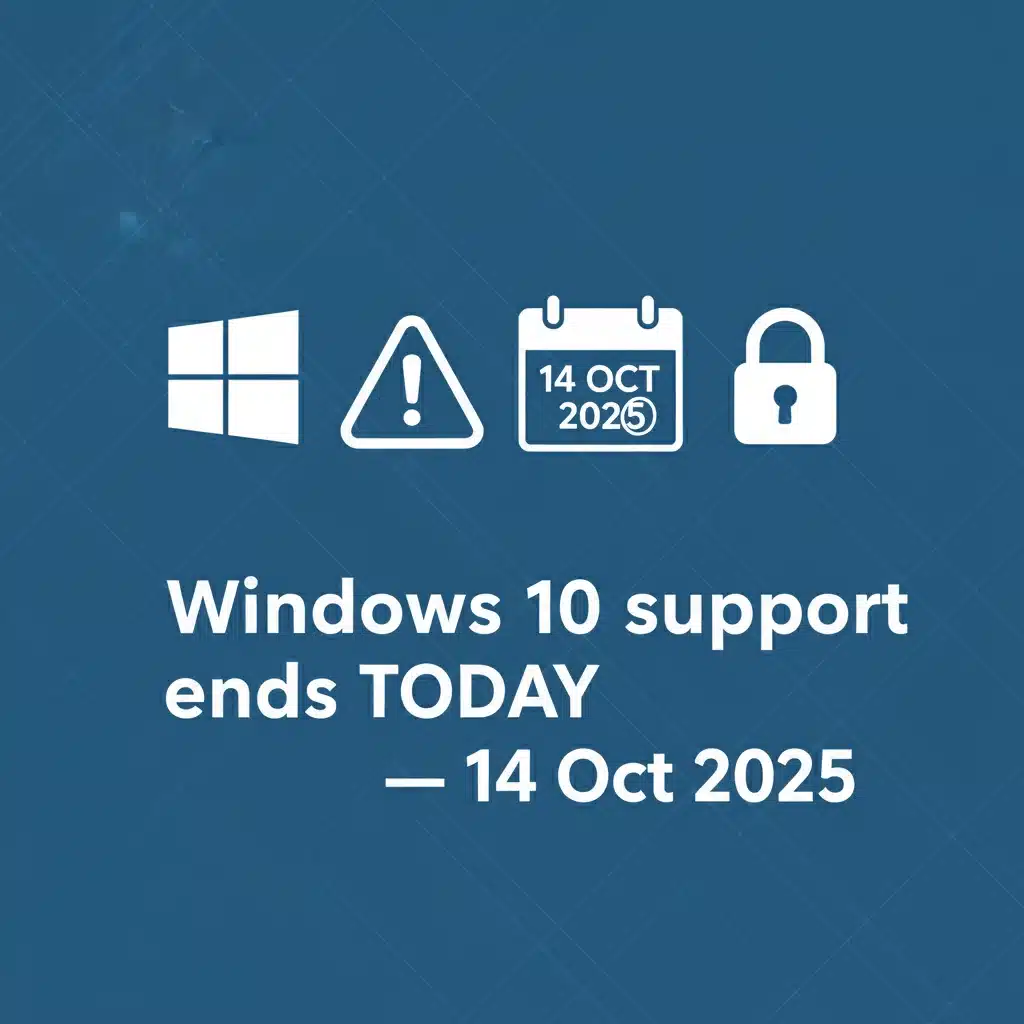It’s official: as of today, 14 October 2025, Microsoft has ended support for Windows 10. If you’re still running Windows 10, this isn’t just a routine update you can snooze. It’s a business-critical moment that puts your systems and data at higher risk starting right now.
Here’s what that means, why it matters, and the steps Aussie businesses should take today.
What “End of Support” Actually Means
From today, Windows 10 will receive no more:
- Security patches for newly discovered vulnerabilities
- Feature updates or improvements
- Technical support from Microsoft
- Bug fixes for system issues
Your Windows 10 devices will still turn on and run your apps. But every day past today increases your exposure. Unpatched vulnerabilities accumulate, threat actors target you more aggressively, and you’re on your own when things go wrong.
The Real Risks If You Keep Running Windows 10
Attackers have been waiting for this day. From today onwards, newly found Windows 10 flaws won’t be fixed by Microsoft, which makes unsupported machines prime targets.
Continuing on Windows 10 exposes your business to:
- Malware infections that spread across your network
- Ransomware that can lock systems and halt operations
- Data theft of customer, financial, and IP data
- Compliance breaches that trigger audits, fines, or lost contracts
- Targeted attacks against known, unpatched Windows 10 systems
- No Microsoft technical support when incidents occur
The Australian Cyber Security Centre consistently warns that unsupported operating systems are a major cause of successful compromises.
Your Options Moving Forward
Don’t panic—you’ve got choices. Prioritise the safest path you can act on quickly.
Option 1: Upgrade to Windows 11 (Recommended)
If your hardware supports it, move to Windows 11. Benefits include:
- Hardware-backed security (TPM 2.0, secure boot)
- Stronger protections against firmware and kernel attacks
- Improved identity security and modern authentication
- Ongoing security and feature updates
Before upgrading:
- Back up critical data
- Confirm your key business apps are Windows 11–compatible
- Check your devices meet Windows 11 requirements (including TPM 2.0)
If a device lacks TPM 2.0 or is too old, jump to Option 2.
Option 2: Buy New Hardware
For older fleets, replacing devices is often faster, safer, and more economical long-term.
Modern business devices provide:
- Windows 11 compatibility out of the box
- Better performance and battery life
- Longer warranties and modern connectivity
- Lower support overheads
Option 3: Extended Security Updates (ESU)
Microsoft’s paid ESU program can provide Windows 10 security patches through October 2026. Treat this as short-term life support while you complete migration.
Caveats:
- ESU is a cost, with no features or performance improvements
- It buys time, not safety forever
- Best reserved for systems with critical legacy software
What Australian Businesses Should Do Right Now
Take these steps today to reduce risk immediately:
Step 1: Review your device inventory
List every device, its role, OS version, age, and Windows 11 readiness (TPM 2.0, CPU generation, RAM, storage).
Step 2: Prioritise migration by business risk
Triage by impact and exposure:
- Finance, payroll, CRM, and customer data systems first
- Public-facing and remote-access devices next
- Low-risk or kiosk machines last (but don’t ignore them)
Step 3: Make a plan for upgrades
Decide per device: upgrade to Windows 11 or replace with a new machine. Schedule rollouts, backups, app testing, and staff comms.
Step 4: Implement extra network protections (temporary)
While you migrate, add layers to reduce blast radius:
- Segment/isolated VLANs for Windows 10 devices
- Tighten admin rights and enable application allowlisting
- Enforce MFA everywhere; strengthen conditional access
- Deploy/verify EDR, DNS filtering, and email security
- Patch browsers and third‑party apps aggressively
- Verify offline, immutable backups and test restores
Step 5: Get expert guidance
Engage a trusted partner to validate your plan, accelerate deployment, and minimise downtime.
The Compliance and Insurance Angle
Unsupported systems can put you out of step with obligations like privacy, PCI-DSS, ISO/ISM, and contractual security clauses. Consequences can include:
- Loss of certifications
- Contract cancellations
- Regulatory fines
- Cyber insurance exclusions or claim rejections
Why Waiting Is Risky
Delaying migration increases the chance that:
- Critical software stops working as vendors drop Windows 10 support
- New hardware and drivers aren’t provided for Windows 10
- Cyber insurance and compliance requirements won’t be met on unsupported systems
- Recovery from an incident takes longer and costs more without vendor support
Don’t Fall for the Scams
Big deadlines attract scammers. Watch out for:
- “Microsoft” cold calls about upgrades
- Pop-ups offering “urgent Windows updates”
- Phishing emails with fake installers
- Cheap “tech support” offers
Microsoft won’t call you to upgrade.
Making the Transition Smooth
Whether upgrading or replacing, smooth the path by:
For software compatibility:
- Test core apps on Windows 11
- Confirm vendor support and versions
- Line up alternatives for legacy apps
For data migration:
- Use cloud storage to streamline file moves
- Document current settings/configs
- Schedule realistic maintenance windows
For staff training:
- Share quick-start guides for Windows 11
- Run short training sessions
- Expect a brief productivity dip
The Silver Lining
This is a chance to modernise:
- Faster, more reliable devices
- Stronger security baselines
- Better app compatibility and features
- Lower long-term maintenance costs
Need a Hand? Cloud Computer Company Can Help Today
Cloud Computer Company helps Aussie businesses move off Windows 10 with minimal disruption. As local cloud and IT specialists, we provide:
- Expert migration to Windows 11 and/or new devices
- IT roadmapping and budget planning tailored to your business
- Secure, tested deployments with end-to-end onboarding
- Data migration, app compatibility testing, and user training
- Proactive monitoring, ongoing support, and disaster recovery planning
Let’s make your upgrade safe, fast, and stress-free—without downtime surprises.
Visit www.cloudcomputercompany.com.au to get started today.
The Bottom Line
Windows 10 support ended TODAY. Your devices will keep running, but the risk grows every day you stay on an unsupported OS. Prioritise migration, add temporary protections, and get expert help so you’re secure, compliant, and ready for what’s next.




